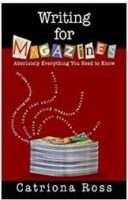The service piece: a freelancer’s friend
Service stories give readers information on products, facilities or services, often using comparisons: ‘The City’s Best Pet Grooming Parlours’, ‘The Top 10 Villa Vacations’, ‘Where to Find a Kick-ass Cappuccino’. These stories involve much schlep for the writer – fact hunting, fact checking, call making, list compiling with 100% accuracy – which is why staff writers avoid them. And why, for an upcoming freelancer, they can be the perfect foot in the magazine door. It’s best to write a service piece on a topic you know about, and pitch it to a magazine at least four months before the appropriate season. A feature on surfing schools shouldn’t be pitched at the end of summer, for instance. Service pieces often work well with a local focus, so consider approaching a city magazine or other local publication with your idea.
Ask a features editor: What do you look for in an article?
‘We accept stories that are relevant to a Cosmo reader – a 20-something single or dating woman. These can include anything from celebrities to sex, psyche to relationships. But the stories need to have a fresh take and be applicable to local women.’
Cathy Lund, assistant editor, Cosmopolitan
Ask a writer: How do you find story ideas?
‘Some periods are more fruitful than others, but when I’m on a roll I come across more stories than I know what to do with. I pick them up interviewing people for other stories, networking at launches and functions, talking to friends, reading overseas magazines and local newspapers, surfing the Net, and often from PR people. I try to do stories on subjects I’m actually curious about or even passionate. It makes life more interesting and usually makes the story more interesting as well.’
Hilary Prendini Toffoli, freelance features writer and columnist
‘I spend a lot of time in what I euphemistically term “contemplation”. I also read widely – newspapers, magazines, Internet.’
James Siddall, freelance writer
‘The newspaper is my main source of information. I read the paper religiously every morning, always reading the “what’s on” columns and the ads. You’ll often find talks, debates and alumni lectures advertised. Read the news stories to find out who’s visiting your city – that’s how I saw Nobel Peace Prize winner Wangari Maathai would be visiting and got to interview her in a car between her other appointments.
Read magazines. You don’t have to buy them all. I go to my local coffee shop, sit there, and page through their magazines. Regard it as part of your work.
I have an architect friend and a theatre backstage manager friend who feed me story ideas. I also belong to a number of clubs and associations outside of writing. I belong to a mountain club and get interesting story ideas through that. There’s information on writers’ association websites, but all the other journalists get that too. Try to beat the competition by being out there’
Judy van der Walt, freelance writer and photographer
Ask an editor: What’s your advice to prospective magazine journalists?
‘Start off with ideas that are familiar to you, things you can write about knowledgeably and honestly. Look around your world, and if you’re observant enough, you’ll see a story and there’ll be a magazine that’ll buy it – seriously. The best stories are those that are closest to us, and chances are if you find it funny, useful or surprising, so will others in your age or interest group. Magazine editors are always looking for fresh ideas and new solutions to deliver to readers. If you’re an aspiring writer and looking to break into magazines, don’t be put off by the fancy mastheads and glossy pages. Pick your favourite, see what they do, get to know the sections, structure and style, and go out and find some interesting ideas, whether it’s skate gangs or shark spotters. Then do some research, find an original angle and pitch the idea. And keep pitching. Be resilient and it’ll pay off.’
Jason Brown, editor, Best Life


